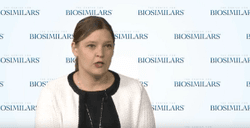Stakeholders Summit: Provider Education on Biosimilars - Episode 11
Misconceptions About Interchangeability
Gillian Woollett, MA, DPhil: The next big issue is interchangeability. Now, as you know, in Europe interchangeability is used more as a practice-of-medicine concept, switching between the biosimilar and its reference under the authority of the given prescriber. And in Europe, as a central regulatory decision, there is no designation by the [European Medicines Agency, EMA] as to whether a product is interchangeable or not.
Now the regulators have published, in their independent capacity, that they consider every biosimilar they’ve approved as already interchangeable with its reference. Meanwhile, the FDA has said, as a prescribing decision, FDA agrees with that same concept. Every product they’ve approved as a biosimilar can be switched by a physician for its reference. But in the United States, as a matter of law, the so-called interchangeability designation is to allow the pharmacist to be able to switch, subject to state law, but in a manner of a generic that’s therapeutically equivalent, a biosimilar for its reference, based on their own judgment, and which may be financial as to what’s beneficial to the patient.
So we have a difference between Europe and the United States. But it’s also led to this confounded situation, going back again to the citizen petition, that many physicians are apparently waiting on the FDA designation in order to themselves feel comfortable with switching between a biosimilar and its reference.
So if I can ask the question, do you think this is a pervasive problem even for those biosimilars, biologics that are both prescribed and administered by the physician? Is there going to be a reluctance to switch patients that are currently being prescribed the reference to the biosimilar? And then, Juliana, I’ll turn to you on the impact we think that has economically for the future of biosimilars.
Kashyap Patel, MD: As a prescribing physician, I’m not terribly concerned about interchangeability once the FDA has approved the drug. The challenge, in all honesty, is that we need to let patients know that we are going to switch them over to a different drug with established efficacy, safety, and the profile that exists.
The problem may become more confounded because, in the United States, again, the healthcare system is different than in Europe. So in the hospital system, a lot of times it’s a pharmacy director who makes the decision about going for a contracting piece. So, if a hospital has contracted with a manufacturer to use only 1 class of drug, then clearly everybody automatically switches over. So interchangeability does not even remain as a question.
For our practice, for example, being in the oncology care model, we have an obligation and partnership with [the Center for Medicare and Medicaid Innovation, CMMI] to look into less expensive, equally effective, safe alternatives to what we can do. So we didn’t have an issue switching our patients into the biosimilar [granulocyte colony-stimulating factor, G-CSF].
There may be some differences when it comes to the pharmacy benefit managers, how they administer the drug, if they take a step therapy approach within a different class. So this is an issue that probably, again, would have to be resolved by joint efforts from the manufacturers, from the FDA, as well as from, again, the physician, which includes the GPOs [group purchasing organizations] and everyone else, to adapt to the fact that we have a less expensive, equally effective, safe alternative approved by the FDA that are available and that we can we run with.
Gillian Woollett, MA, DPhil: So what I’m hearing from you is that as a physician you don’t have a problem.
Kashyap Patel, MD: I don’t have a problem.
Gillian Woollett, MA, DPhil: Operationally, there are still some significant challenges. Julie, can you address how this impacts the prospects? The prospects for biosimilars commercially in the United States.
Juliana Reed: I will address the misinformation. I think that’s really important because yes, thank you for stating that the physicians don’t require interchangeability.
And what we’re seeing impacting the marketplace is that we have seen payers, and purchasers, and some stakeholders say that they don’t want the biosimilar. They cannot cover the biosimilar or provide access to the biosimilar until it is interchangeable. And that misinformation is another piece the FDA needs to clarify.
As of today, there are 7 biosimilars in the marketplace in the United States. None of them are interchangeable. We don’t have the interchangeable guidance yet to develop an interchangeable biosimilar. Yet, prescribers can prescribe biosimilars, and they should be. Payers and insurers can provide access to biosimilars and cover them without the biosimilar being interchangeable. If folks are waiting for interchangeability before they cover or prescribe a biosimilar, we’re going to continue to see low market uptake. So that’s a key piece to correct that misinformation. We need these stakeholders, these insurers, the physician to prescribe these products.
Carlos Sattler, MD: And I think part of the misinformation or misunderstanding is that somehow there is a belief that an interchangeable biosimilar is a better or higher quality biosimilar than a non-interchangeable biosimilar. Somehow, it’s a better product. When, in fact, a designation of interchangeability relies not on a better product but on additional data and additional analyses. It’s the same product. We’ve heard that some stakeholders are waiting, whether physicians or others, for an interchangeable product because they believe it’s just a better biologic, and that is not true. And I think that’s part of the misconception, misperception, misinformation.
Juliana Reed: We need to limit interchangeability to what it is. It’s a pharmacy substitution enabler.
Gillian Woollett, MA, DPhil: Yes.
Juliana Reed: So that a pharmacist can interchange and substitute without calling a physician.
Gillian Woollett, MA, DPhil: Even though in the United States it’s a unique additional opportunity, it’s now being used to prejudice the mere biosimilar that in Europe they don’t have the designation at all.


